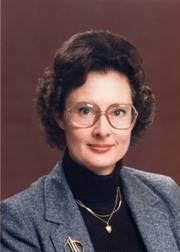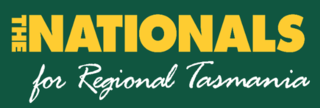
The Australian Greens (AG), commonly referred to simply as the Greens, are a confederation of green state and territory political parties in Australia. As of the 2022 federal election, the Greens are the third largest political party in Australia by vote and the fourth-largest by elected representation. The leader of the party is Adam Bandt, with Mehreen Faruqi serving as deputy leader. Larissa Waters currently holds the role of Senate leader.

Janine Winton Haines, AM was an Australian politician who was a Senator for South Australia from 1977 to 1978 and again from 1981 to 1990. She represented the Australian Democrats, and served as the party's leader from 1986 to 1990, becoming the first female federal parliamentary leader of an Australian political party. She was pivotal in "shaping the Australian Democrats into a powerful political entity that held the balance of power in the Senate".

Norman Kirkwood Ewing was an Australian lawyer, politician and judge. He was born in New South Wales and moved to Western Australia in the 1890s. He served in the Western Australian Legislative Assembly from 1897 to 1901 and was elected to the Senate at the inaugural federal election in 1901. He resigned from the Senate in 1903 and moved to Tasmania in 1905, serving in the Tasmanian House of Assembly from 1909 to 1915. His last public role was as a judge on the Supreme Court of Tasmania from 1915 until his death in 1928.
This is a list of the members of the Australian Senate in the First Australian Parliament, which was elected on 29 March 1901. There were 36 senators in this initial parliament. Terms were deemed to start on 1 January 1901. In accordance with section 13 of the Constitution, the Senate resolved that in each State the three senators who received the most votes would sit for a six-year term, finishing on 31 December 1906 while the other half would sit for a three-year term, finishing on 31 December 1903. The process for filing of casual vacancies was complex, with an initial appointment followed by an election. The status of political parties varied, being national, State based, and informal.

The 1903 Australian federal election was held in Australia on 16 December 1903. All 75 seats in the House of Representatives, and 19 of the 36 seats in the Senate were up for election. The incumbent Protectionist Party minority government led by Prime Minister Alfred Deakin retained the most House of Representatives seats of the three parties and retained government with the parliamentary support of the Labour Party led by Chris Watson. The Free Trade Party led by George Reid remained in opposition.

The 1906 Australian federal election was held in Australia on 12 December 1906. All 75 seats in the House of Representatives, and 18 of the 36 seats in the Senate were up for election. The incumbent Protectionist Party minority government led by Prime Minister Alfred Deakin retained government, despite winning the fewest House of Representatives votes and seats of the three parties. Parliamentary support was provided by the Labour Party led by Chris Watson, while the Anti-Socialist Party, led by George Reid, remained in opposition.
This article provides information on candidates who stood for the 1919 Australian federal election. The election was held on 13 December 1919.

Edward Mulcahy was an Irish-born Australian politician. Born in County Limerick, he migrated to Australia as a child and was educated in Tasmania. He became an apprentice compositor and established a soft goods business in Hobart. In 1891 he was elected to the Tasmanian House of Assembly for West Hobart, serving until 1903, including a period from 1899 to 1903 when he was Minister for Lands and Works and Minister for Mines. In 1904, he was elected to the Australian Senate as a Protectionist Senator for Tasmania. Defeated as a Liberal in 1910, he returned to the House of Assembly as the member for Wilmot, serving as Minister for Lands and Works, Minister for Mines and Minister for Railways 1912–1914. In 1919, he left the Assembly and was appointed to the Senate as a Nationalist, filling the vacancy caused by Labor Senator James Long's resignation. He retired in 1919.
This article provides information on candidates who stood for the 1937 Australian federal election. The election was held on 23 October 1937.
This is a list of members of the Australian Senate from 1923 to 1926. Half of its members were elected at the 13 December 1919 election and had terms starting on 1 July 1920 and finishing on 30 June 1926; the other half were elected at the 16 December 1922 election and had terms starting on 1 July 1923 and finishing on 30 June 1929.
This is a list of members of the Australian Senate from 1917 to 1920. Half of its members were elected at the 5 September 1914 election and had terms notionally starting on 1 July 1914 and finishing on 30 June 1920; the other half were elected at the 5 May 1917 election and had terms starting on 1 July 1917 and finishing on 30 June 1923.
This article provides information on candidates who stood for the 1961 Australian federal election. The election was held on 9 December 1961.
This article provides information on candidates who stood for the 1966 Australian federal election. The election was held on 26 November 1966.
This article provides information on candidates who stood for the 1972 Australian federal election. The election was held on 2 December 1972.
This article provides information on candidates who stood for the 1975 Australian federal election. The election was held on 13 December 1975.
This article provides information on candidates who stood for the 1996 Australian federal election. The election was held on 2 March 1996.

The Tasmanian Nationals are a political party in the Australian state of Tasmania, aligned with the National Party of Australia. The party is not currently registered with the Tasmanian Electoral Commission, and is not separately registered with the Australian Electoral Commission, unlike the other state branches of the Nationals.
The Australian states each elected three members of the Australian Senate at the 1906 federal election to serve a six-year term starting on 1 January 1907.
The 1917 Australian Senate election was held on 5 May 1917 to elect 18 of the 36 senators in the Australian Senate as part of the 1917 federal election. Each state elected three senators to serve a six-year term beginning on 1 July 1917.
The 1922 Australian Senate election was held on 16 December 1922 to elect 19 of the 36 senators in the Australian Senate as part of the 1922 federal election. Each state elected three senators to serve a six-year term beginning on 1 July 1923, except for Queensland, who elected an extra senator to fill a casual vacancy.









